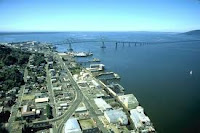
 If you are driving up the Oregon coast, the mouth of the Columbia River is not only picturesque but is also the site of three historic military forts that were at one time strategic defenses for the U.S. Fort Stevens was constructed near the end of the Civil War to guard the mouth of the Columbia River. Fort Stevens Park is on the Oregon side. There were two additional forts on the Washington State side, Fort Canby and Fort Columbia.
If you are driving up the Oregon coast, the mouth of the Columbia River is not only picturesque but is also the site of three historic military forts that were at one time strategic defenses for the U.S. Fort Stevens was constructed near the end of the Civil War to guard the mouth of the Columbia River. Fort Stevens Park is on the Oregon side. There were two additional forts on the Washington State side, Fort Canby and Fort Columbia.
Ft Stevens was an active military installation from 1863 to 1947. It was originally built to counter any British intervention during various regional conflicts such as the Pig Wars along the San Juan Islands further north. Today old Fort Stevens is Fort Stevens State Park. an Oregon State Park and it's also on the National Register of Historic Places. What is also very interesting about Fort Stevens is that being operational for a period of 84 years, it obviously served the U.S. defense system much longer than the vast majority of military posts built in the mid 19th century. Fort Stevens Park remains a good historic tourist top. Also at the mouth of the Columbia is Cape Disappointment State Park which is on the Washington State side with a lot of Lewis and Clark expedition history.
Attacked During World War Two
 An interesting side note about Fort Stevens is that it was attacked during World War II by a Japanese submarine in late June 1942. The submarine fired 17 shells at the fort causing damage only to the fort's baseball field backstop. The guns at the fort did not return fire and the submarine sailed on. Fort Stevens was the only mainland U.S. military installation actually attacked by the Japanese during the war. There were two other instances where the Japanese shelled a petroleum platform off of Santa Barbara, CA with minimal damage and a small aircraft launched from a Japanese submarine off the Oregon coast which dropped incendiary devices into the forests. The fires were put out quickly with no real damage caused.
An interesting side note about Fort Stevens is that it was attacked during World War II by a Japanese submarine in late June 1942. The submarine fired 17 shells at the fort causing damage only to the fort's baseball field backstop. The guns at the fort did not return fire and the submarine sailed on. Fort Stevens was the only mainland U.S. military installation actually attacked by the Japanese during the war. There were two other instances where the Japanese shelled a petroleum platform off of Santa Barbara, CA with minimal damage and a small aircraft launched from a Japanese submarine off the Oregon coast which dropped incendiary devices into the forests. The fires were put out quickly with no real damage caused.
Another side note is that Fort Canby on the Washington side of the river was named after a U.S. Army Colonel who was killed at a parley with the Modoc Indians (along the California/Oregon border) in April 1873. The parley was to try to agree on a peace settlement which the Modocs thought would allow them to remain in their native area. The meeting went badly and a group of Modocs plotted to have Col. Canby and other peace commissioners killed.
(Photos from the public domain)
Here are excellent web sites to give you more information on the area:

